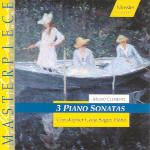Listen to the aching lyricism and pungent harmonies of the Op. 25 No. 5 sonata’s slow movement, the unexpected plot twists in the opening movement’s development section, or the finale’s Schubertian turns of phrase (years before Schubert was born, mind you!) and you’ll wonder why Muzio Clementi’s piano sonatas still haven’t entered the so-called “standard” repertoire. Similarly, the Op. 13 No. 6 F minor sonata’s brief first movement is packed with enough ideas to supply Beethoven for life. Actually, the first movement of the Op. 34 No. 2 G minor sonata’s slow introduction and its reiteration into the body of the movement specifically foreshadows Beethoven’s more famous “Pathetique” sonata.
Christopher Czaja Sager’s superlative performances make an impassioned and fervent case for these wonderful pieces. I love the angular, surging brio and blinding drama with which he inflects the aforementioned F minor sonata’s triplet patterns and ascending scales, and how Sager’s full-throated, operatically tinged phrasing propels the inherent drama of each slow movement to almost unbearable heights of intensity. In fact, he brings more varied articulation, dynamic contrast, and motivic clarity to the G minor sonata’s finale than Vladimir Horowitz did in his long-admired 1954 traversal. The plangent timbre and subtle registral differentiation of Sager’s Bösendorfer concert grand doesn’t hurt either. In sum, this is the finest bargain to be had in Clementi sonatas, along with Pierto De Maria’s terrific Naxos accounts of the Op. 40 Sonatas. Don’t let Hänssler’s lack of annotations stop you from acquiring it ASAP. [1/23/2002]
































